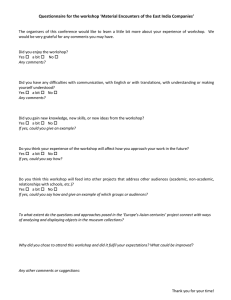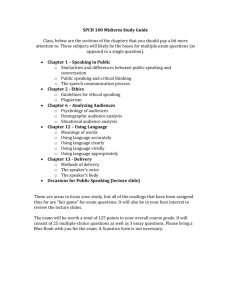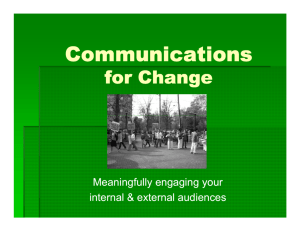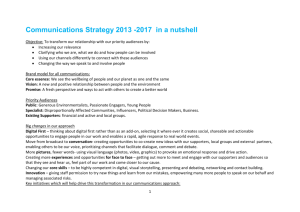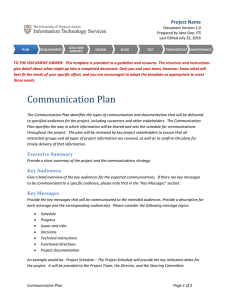Using Social Marketing to Achieve SMART About Water Goals: An Introduction
advertisement
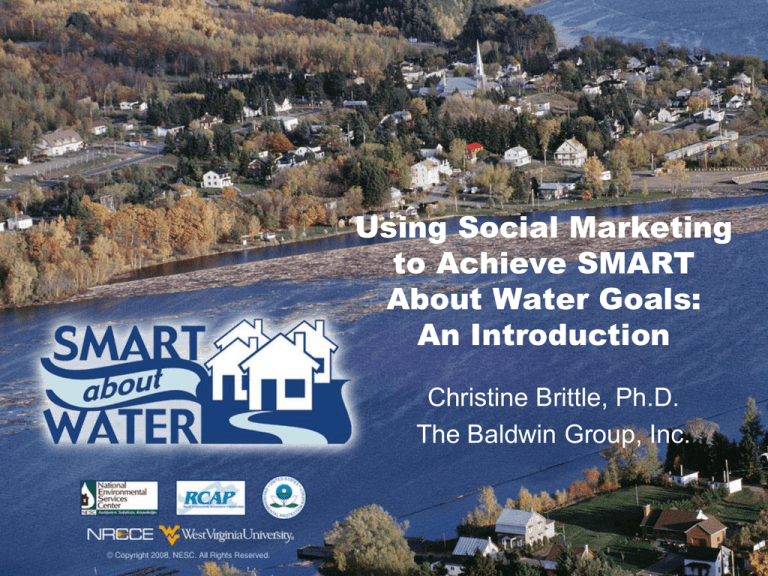
Using Social Marketing to Achieve SMART About Water Goals: An Introduction Christine Brittle, Ph.D. The Baldwin Group, Inc. SMART Social Marketing • Social marketing is a strategic component of SMART About Water: – SMART trainers do not need to be social marketing experts. – Social marketing is meant as a helpful perspective to achieve SMART objectives; social marketing approaches should be used wherever possible throughout SMART. – We hope that trainers will be strategic and audience-specific whenever possible – this makes us all social marketers! Social Marketing Training Goals 1. 2. 3. 4. 5. 6. 7. Define social marketing. Describe how social marketing is different from conventional outreach approaches. Understand the importance of segmenting audiences and focusing on outcomes. Understand why it is important to take audience needs/wants/preferences into consideration when interacting with communities. Describe key characteristics of the eight SMART audiences. Understand how to conduct basic market research (in the form of audience listening) to learn more about target audiences. Understand how social marketing can be employed at the ground level in the SMART initiative. Exercise: Introduction to Social Marketing • Pair up in groups of 2 • Find something that you and your partner like to do that not everyone else might like to do (hiking, sky diving, cooking, etc.) • Think about how you would convince the following people to join you in this activity: – The Pope – Your mom – Your taxicab driver Exercise Discussion • Share your activity and your three approaches: – How were they different for each audience? How were they the same? – Was it easy or difficult to adjust your approach for each audience? • Congratulations! You’re on your way to becoming social marketers! What is Social Marketing? • The application of commercial marketing techniques + • To influence a key target audience + • To voluntarily change a behavior = • For the good of society Key Point Social marketing is about being strategic. Pick a crucial issue and a key audience. Then, think about the issue from the perspective of your target audience. Pretend that their perspective is all that matters. Because it is. The 4Ps of Social Marketing Marketing is more than communications: • Product – The action/behavior you are interested in influencing • Price – What is costs (not just $) • Place – Where it happens (convenience) • Promotion – How people learn about it Why Social Marketing is Effective • Social marketing recognizes that information alone does not change behaviors • Social marketing focuses on target audiences, including their needs, wants, and motivators • Social marketing focuses on making behaviors easy, fun, and popular! Social Marketing is Strategic • We don’t have unlimited time, resources, or personnel • Social marketing makes us focus on: – The most important messages – The most important people • Everything else can wait until later Social Marketing is Audience Focused • Audiences are the beginning and end of social marketing • Think of your audience continuously: – – – – – Are they interested in your issue? Do they care about your issue? What are they passionate about? What do they need to know about your issue? How do they want to find out? • Whenever possible, select audiences who can help you reach your goals and who are motivated to act Social Marketing Segments Audiences • Not all people are the same, so not all people can be treated the same • Break your audiences into similar groups based on things such as: – Interest level – Wants and needs – Motivators – Access points Social Marketing is Outcome Focused • If they believe you and they aren’t doing it, it doesn’t matter! • If they understand you and they aren’t doing it, it doesn’t matter! • If they like you and they aren’t doing it, it doesn’t matter! • AND, if they ARE doing it, we don’t care why! Social Marketing Relies on Exchange • Recognize that we are asking for a tradeoff • Acknowledge competing behaviors • State clearly what you are offering and know what you are asking: – You get = Safer water, peace of mind – You pay = Time, higher water bills Social Marketing Addresses Barriers • Barriers are real but often downplayed or ignored. This is a huge mistake! – Barriers can be physical, emotional, social, monetary, or time-oriented – Barriers can be subconscious • Social marketing is about finding effective bridges to overcome these barriers Social Marketing and Stages of Change • People go through a series of five stages in changing behaviors (pre-contemplation, contemplation, preparation, action, maintenance/advocacy) • It takes time to change behaviors, and change is not linear (people regress) • Messages/interactions should be targeted to each stage 1. Pre-contemplation • Definition: No awareness of need to modify behavior, and no intention to do so (lack of personal relevance) • Messaging: Start helping people to understand the issue – focus on awareness, not persuasion 2. Contemplation • Definition: Know that the issue exists and audience members are considering action • Messaging: Build on initial understanding; messages can start attempting to influence behavior change 3. Preparation • Definition: Preparing to take action, but not yet engaged in behavior; might be learning about behavior • Messaging: Address barriers to change and encourage behavioral “trials” to sample intended behaviors or preparations such as learning where to buy needed tools, etc. 4. Action • Definition: Actually engaging in behavioral change • Messaging: Support, encourage, and reinforce change 5. Maintenance/Advocacy • Definition: Change has occurred and is being sustained • Messaging: Reinforce change and encourage audience to spread the word; people in this stage often can influence others [these people are sometimes called spark plugs or opinion leaders] Stages and Appropriate Requests • Stage of change influences what we ask of audiences (and how we ask it) • Asking too much of an audience may lead to them “tuning out” or ignoring the request • Tip: Request actions that are consistent with stage of change; make your requests reasonable for your audience Discussion: What’s Different? • Based on this overview, how is social marketing different from traditional outreach? • What is the biggest change you see between your typical approaches and social marketing? • How have you already been doing social marketing? How SMART is using Social Marketing • SMART is a social marketing initiative: – It is focused on a key issue (wastewater as a critical and overlooked threat) – It is focused on a key objective (get small communities to engage in source water protection and planning) – It is focused on reaching key audiences with messages that work (audience-focus) Understanding SMART Audiences • SMART recognizes that it cannot (and should not) try to reach everyone • It wants to reach the most critical audiences with the most critical messages – The national planning workshop identified eight key audiences for this effort Know Your Audience • To successfully engage in social marketing, you have to know your audience: – What do they know? – What stage of change are they in? – What do they like? What interests them? – What motivates them? – What are their barriers to change? Discussion: Priority Audiences • We need to reach audiences that: – Possess critical information – Can make decisions – Are active and involved in the community – Influence others – Generally make things happen • Based on this, who should SMART reach? Why? 8 Identified SMART Audiences • First priority audiences: – – – – Local/elected officials Operators Homeowners/landowners Watershed groups/associations • Second priority audiences: – Homeowner associations, septic professionals, civic groups, NCWS • See detailed information on each audience Local/Elected Officials • Who: Many levels of leadership, often not a full-time job as a leader • Knowledge: Ins and outs of local community • Motivators: Serving community, reduced complaints, saving money • Barriers: Lack of time and financial cost to address issue Community Water System Operators • Who: In charge of many things, not just water system • Knowledge: About doing their job, but less about community outreach/policy change • Motivators: Do the right thing, save time, less monitoring • Barriers: Don’t have authority, little time Homeowners and Landowners • Who: Individuals with on-site septic systems living in small communities • Knowledge: Know about on-site systems • Motivators: Protect water, save money, protect property values • Barriers: Source of problem may be outside jurisdiction, limited interest until “crisis” occurs Watershed Groups and Associations • Who: Groups with a specific water focus • Knowledge: Lots about water in general, not as much about septic/drinking water • Motivators: Doing the right thing, making a difference, activism • Barriers: Distrusts industry, dislikes compromise Homeowner Associations • Who: Groups of homeowners living in clustered communities • Knowledge: Varies greatly, some will know more than others about this issue • Motivators: Protecting drinking water, saving money • Barriers: Issue is complex and potentially expensive to deal with Septic Installers and Service Providers • Who: Mostly small business people who interact with customers • Knowledge: Lots about septic, less about source water protection • Motivators: Business-oriented, making money • Barriers: Lack of time Civic/Special Interest Groups • Who: Involved individuals within a community • Knowledge: How to get things done in their community • Motivators: Doing the right thing, positive publicity • Barriers: Competing with other issues Non-Community Water Systems • Who: Mostly part-time operators • Knowledge: Often understand both drinking water and wastewater • Motivators: Technical assistance, ability to be involved in community • Barriers: Lack of time, not adept at communications with others Similarities Across all Groups • Time is limited • Prefer short messages • Agreement that issue is important, but understanding is limited/incomplete • Few resources (financial or time) to readily devote to this issue • Other competing priorities Differences Across Groups • Initial interest in this topic • Willingness to work on this topic • Level of authority to solve problem or address issue • Level of comfort in working with others in community to solve problems • Communication styles and preferences Discussion: Being Audience Specific • Based on these brief profiles, how do you think you might approach these audiences differently? Think about: – Operators vs. watershed groups – Community groups vs. septic professionals – Local officials vs. homeowners – Non-community operators vs. homeowner associations Looking Ahead … • Tomorrow we will talk about using social marketing to: – Learn about Audiences – Select Audiences – Recruit Audiences – Work with Audiences – Deal with Frequent Problems Using Social Marketing to Achieve SMART About Water Goals: Applications Christine Brittle, Ph.D. The Baldwin Group, Inc. Recap from Yesterday • Social marketing is a mindset: It’s about being ruthlessly focused on your audience • Social marketing is strategic: Don’t just tell everyone everything you know, think about who needs to know what and how they need to know it Discussion: Tailored Messages • Watch the following public service announcements: – How are they tailored for specific audiences? – What do they assume people care about? – Do you think they would be effective? – Why or why not? It’s a nice idea, but … • How can I really use social marketing in my work under SMART? – Social marketing is a mindset (audience, audience, audience) – Social marketing is a series of well-defined steps 5 Stages of Social Marketing • Define Problem: Know what you want to do and why (your expertise is key) • Market Research: Understand your audience: barriers, motivators, etc. • Planning: Determine best way to reach audiences and to achieve goals • Implementation: Make it happen • Evaluation: Define and measure successes 1. Define Problem • Formally and specifically identified in the SMART grant: – Source water protection for small and very small systems (most in need of assistance) – Addressing wastewater issues (key threat) – Training in 245 communities – Hands-on assistance in 18-24 communities 2. Market Research • Learn about your target audience and their needs, wants, and desires: – Eight key audiences were identified at the national workshop – Audience profiles for each audience were developed – You will gather additional information about each audience in the field via audience listening techniques 3. Planning • Within each community, determine the key audiences (they will vary from place to place). Identify: – What you need the audience to do, what you need them to know, and the specific exchange you are asking of them (product) – Any barriers they face and what they see as benefits (price) – Where to get them information/interact with them (place) – How and where to communicate best with them and to motivate them (promotion) 4. Implementation • Take into consideration what you already know about each audience • Make adjustments as needed based on audience listening • Use social marketing techniques with every audience whenever possible 5. Evaluation • Evaluation is being conducted as a separate part of the grant. Evaluation will focus on: – Stages of change for various target audience members – Evaluation of technical assistance calls – Publications/publicity about the program Applying these 5 Steps • • • • 1 – Define problem (we have our goals) 2 – Market research (listening) 3 – Planning (considering audiences) 4 – Implementation (working with audiences) • 5 – Evaluation (help as needed) SMART Market Research • The national workshop gave an “expert” overview of the target audiences, but you will have the opportunity to work specifically with these groups • Take advantage of opportunities in each community to do your own market research to learn more about key audiences Audience Listening • The simplest, cheapest, easiest form of market research is audience listening (and it is surprisingly effective) • Go, ask, listen. No judgment allowed. • Use open-ended questions: – What are you concerned about in your community? Who do you work with to get things done? Do you ever think about your drinking water? Why or why not? Exercise: Audience Listening Practice • Pair up in groups of 2 • Find out what each person’s favorite sport or sports competition is, and what they like about it • Your challenge is to be as neutral as possible – Learn as much as you can without giving away anything about whether you like it or not • Have your partner guess your real thoughts • Use the form on the next slide to get started Sample Interview Questions • • • • • What is your favorite sport? What do you like about it? How does it compare to other activities? How do you participate in it or view it? Is there anything you don’t like about it? Exercise Discussion • Report back: How neutral were we? – Could you guess whether your interviewee liked your sport or not? – Why or why not? – What are some examples of “non-neutral” feedback? – How can we be on the alert for those? Planning: Learn and Prioritize • Learn as much as you can: – Who are the potential audiences? – Who is affected by this issue? – Who can make a difference on the issue? – Who are the people who already care? – Who is most likely to be critical to reach within this community? Why? Exercise: Prioritizing Audiences • As a large group, generate a set of questions to ask yourself when deciding which audiences to work with in any community. Be as specific as possible. Remember, the audience you select to interact with first will vary from community to community. Planning: Recruit an Audience • Once you have identified audiences to work with, you need to determine how to meet with and engage them: – What motivates each audience in general? – What is motivating about this issue? – What are the barriers with this issue? – Where are you likely to encounter audience members? Exercise: Recruit an Audience • Break into four groups (2-3 people per group) • Each group takes one of the top four target audiences (officials, operators, homeowners, watershed groups) and identifies potential ways to recruit that audience • Start by making clear what the specific exchange for the audience is, as well as the motivators and barriers for the audience • Develop a short “pitch” for that audience • Use the form on the next slide to get started Recruiting • • • • • Audience: _________________ Exchange: _________________ Motivators: _________________ Barriers: _________________ Recruiting/involvement “pitch”: _____ _______________________________ _______________________________ Planning: Thinking of the Interaction • Once people have agreed to work with us, our audience focus continues • Remain aware of audience needs and wants: – How do people like to get information? How often? – When and where can they meet? – How will they interact with others? Exercise: Work with Your Audience • Break into two groups (4-5 people per group) • Each group takes one of the top two audiences (officials, operators) and identifies potential ways to work with that audience • Make a plan to describe (see next page): – When and where interactions will occur? – How long they will last? – Barriers you might encounter and how to overcome them Audience Interactions • • • • • • Audience: _________________ Place to interact: _________________ How often: _________________ How long: _________________ Specific barriers: _________________ How to overcome: _________________ Discussion: It’s not my problem … • A frequent barrier we encounter is “it’s not my problem.” – First, evaluate whether there are other audiences to reach first who are more easily motivated. If not: • How can we make it their problem? What issues does it connect to that they do care about? What people? What values? What can we appeal to (e.g., self-image) to make people more interested? Discussion: But this used to be free! • Another barrier is the cost to address problems. – First, ask yourself if the cost is one *you* would pay. If not, rethink your solutions. If you would pay the cost, think about: • How can costs be reduced? How can benefits be enhanced? What are the long-term and short-term costs and benefits? Was the item really “free” before, or were there hidden costs related to health, environment, etc.? Discussion: Why should I care? • Source water protection is often about prevention, not crisis management. Consider: – What are the personal, societal, health, or environmental goals that support prevention? – For what other issues is prevention worthwhile? – At what level of crisis would audience members “automatically” care? Does the community want to get to that crisis stage before taking action? – Is prevention cheaper than dealing with a crisis? – Who does care? How can they influence decision makers? Spreading the Word • Once you’ve formed a good relationship with one or two key audiences, you can help others spread the word • Encourage them to think about social marketing ideas as well – Remember: It all comes down to audience! Sample Additional Resources • Social Marketing Lite: Ideas for folks with small budgets and big problems http://www.aed.org/Publications/upload/ Social-Marketing-Lite-1st-ed.pdf • The Basics of Social Marketing http://www.turningpointprogram.org/Pag es/pdfs/social_market/smc_basics.pdf • Additional resources are in your binders Thank You! • Any additional questions or comments?
